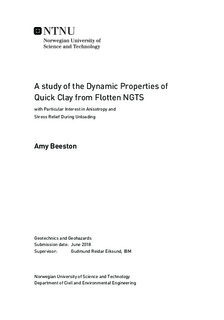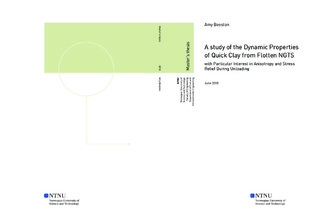| dc.description.abstract | The stiffness of a soil is of great importance in many areas of geotechnical engineering. It forms the link between strain and stress, which is crucial in incremental numerical modelling. More specific to this study, the maximum shear stiffness (Gmax) is the primary parameter used in small shear strain models, earthquake engineering and vibration assessments. Gmax is also used, in recent studies, to determine sample quality and is an important aspect for understanding what happens to a soil sample when it is unloaded and removed from its in-situ environment. Acquiring accurate values of Gmax is problematic, particularly in the laboratory where reduced stiffness is thought to be due to stress relief during unloading, which affects sample quality.
In this study bender element testing was carried out using mini-block samples taken from the Flotten quick clay NGTS near Trondheim. Tests were carried out on unconfined trimmed triaxial samples and consolidated samples at different orientations to assess anisotropy in shear stiffness. Vertical shear stiffness results were compared to in-situ results from a seismic dilatometer test. Shear wave velocity was also measured during unloading to try to imitate and understand unloading effects during sampling.
Strong anisotropy was found in the samples and due to relationships with clay content and behaviour during unloading, it is concluded that this anisotropy would be expected in-situ. Anisotropy was found between rotations in the vertical plane, which is not possible according to a model based on a cross-anisotropic elastic medium. Therefore, the application of equations derived for wave propagation from such a model is brought into question. During unloading it is found that samples with no access maintain their stiffness compared to those whom have access to water where stiffness drops dramatically. | |

